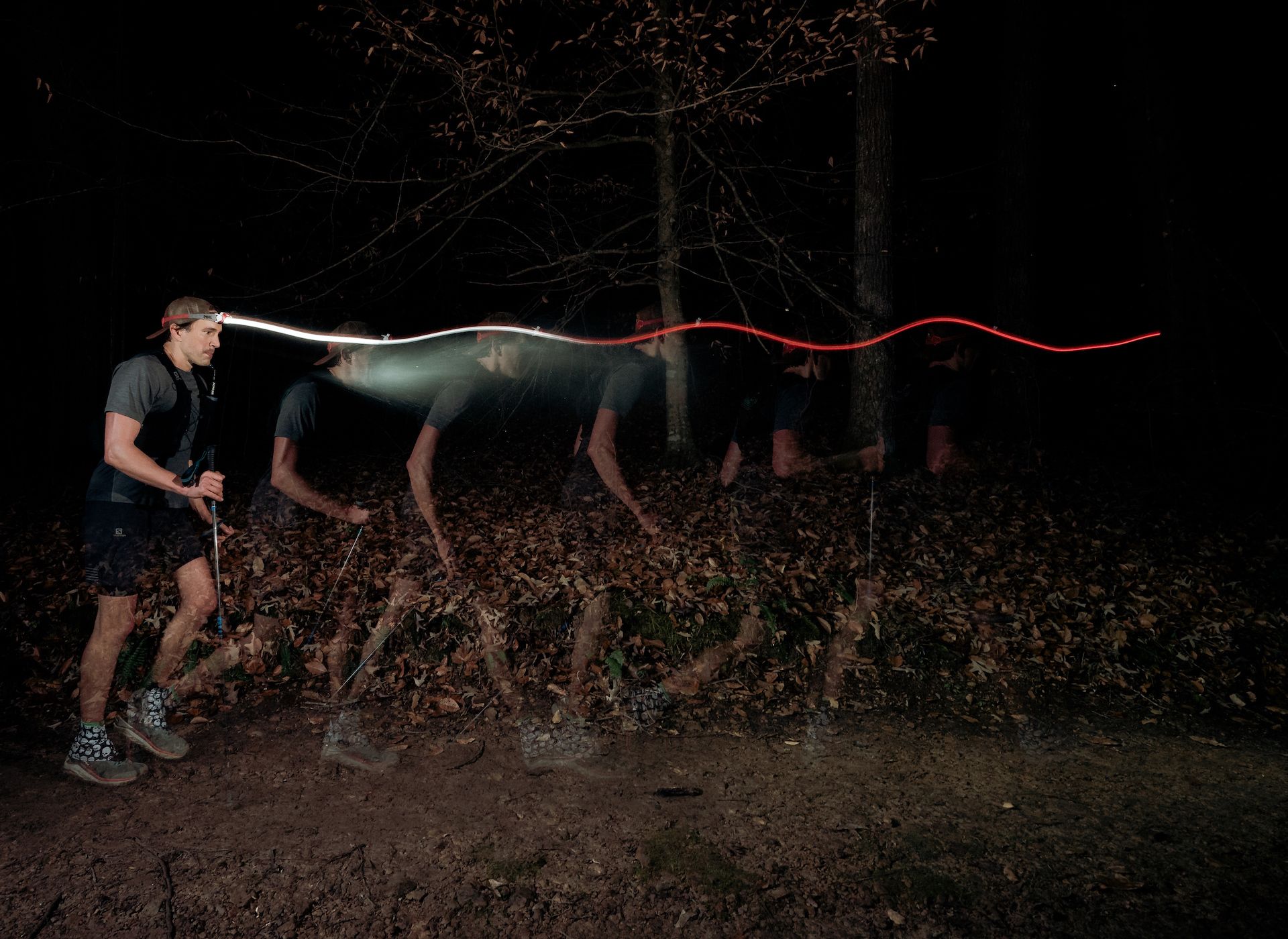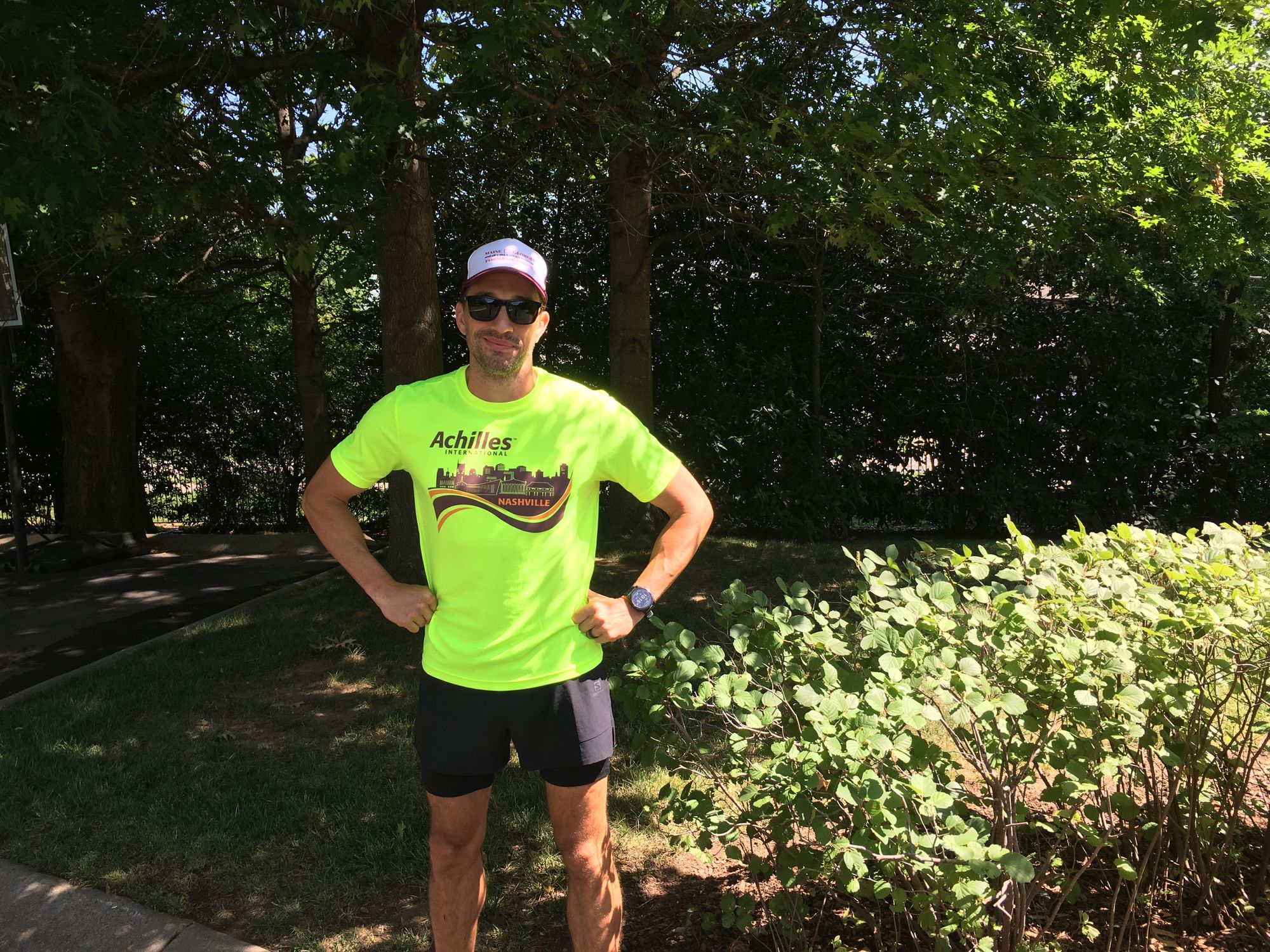
The Personal Performance Artist
Nashville Ultra Runner John Hardin Sculpts Himself into a Self-Mastery Piece
“Whereof what's past is prologue; what to come, in yours and my discharge.”
Shakespeare, The Tempest
It’s predawn, December 9th, 2019, and John Hardin shivers in an Arkansas ditch, doing his best not to die. To promote that cause, John has stuffed wads of hay under his thin running shirt and pants, so has Becca Jones, his pacer for the last leg of the 165-mile Ozark Highlands Trail. Just a few hours earlier, John completed the fastest known time (FKT) recorded over this rugged terrain, clocking in at 2 days, 9 hours, and 17 minutes—1 hour and 29 minutes faster than it had ever been done. Normally, it would be time to celebrate. Normally, the Buffalo River—the last obstacle between the finishing trailhead and the parking lot where John’s van full of hot food, cold beer, and warm sleeping bags awaited—burbles by as little more than a trickle, a stream a kid could cross without getting her knees wet.
But, as irony demands it, the Buffalo, flowing fast and deep and cold on this particular date, might as well be the Styx: a river only the dead can cross. Having just finished the final 17 miles of the trail, a brutal section featuring a steep descent over basketball-sized rocks, John’s body has already begun to shut down, anticipating the comforts to be found inside that van. Mike and Jeff, the two other members of John’s support crew, stand helplessly in the parking lot, shouting to John and Becca across the swollen stream. For 165 miles, the pair supplied all John’s needs: his food, his gear, his hydration. Now, just a 9 iron away from rolling back to Nashville in victory, all they lack is a fucking boat.
At night in the Ozarks, the distant calls of elk sound like ghosts floating through the valleys. Even through his chattering teeth and jackhammering body, pressed to Becca for warmth, John appreciates the sound. His heart has begun to palpitate, and his body temperature has dropped dangerously low. To keep his spirits up, he murmurs the names of those he loves into the frigid darkness. “It’s actually not a bad way to die,” he will recall saying to Becca. “What an adventure!” And John ought to know: the Ozark FKT–which he has successfully garnered, imminent death notwithstanding– isn’t even his first FKT. In April of 2018, he ran the 319-mile Sheltowee Trace from Kentucky into Tennessee in 7 days, 11 hours, and 50 minutes, overcoming obstacles such as sabotaged signs, angry dogs, and hostile locals. At one point, a suspicious-looking guy clad in head-to-toe camo followed him for miles on an ATV until John was able to shake his pursuer by fording a creek through chest-deep water.
But now, in the ditch, there is nothing John and Becca can do but hope for the best while soberly accepting the worst. “Part of me was mad at myself for putting us in that situation,” John shares, “but part of me was also ‘Man, that was pretty badass what you just did.’”
Thankfully, the intrepid trail runners do not die. Instead, in a real-life deus ex machina, tragedy transforms into comedy as a pair of park rangers alerted to the situation by Mike and Jeff show up with a boat. The rangers are shocked by John’s extraordinary accomplishment. Then they save his life. “It took less than a minute to get across that river,” John says, having lived to run another day.
And now another day is here. On June 20th, 2022, John Hardin, founder of HardWin Adventures, will practice what he preaches and attempt the FKT of the Appalachian Trail, all its twisty-turny 2,189 miles replete with 465,000 feet of vertical gain – that’s 88 miles of pure up. The record is currently held by world-renowned ultrarunner Karel Sabbe, a Belgian dentist who crushed the FKT on the AT by four days in August of 2018, becoming the first human to average over 50 miles a day along the rugged route. To beat Karel’s time of 41 days, 7 hours, and 39 minutes, John will have to average just over 53 miles a day. When Karel did it, he was 28; John is 43. Still, as the Duke of Wellington once said in reference to the Battle of Waterloo, the contest between Karel’s time and John’s will promises to be “the nearest-run thing you ever saw in your life.”
Or not. There are innumerable variables to such an effort that simply cannot be controlled, no matter how much an ultrarunner has prepared. Floods, fires, drunken assholes, pissed-off bears, snake bites, lightning strikes: all are possible on the AT. Last July, when John visited Maine to practice the northernmost section of the trail – by far its rockiest – a lightning bolt from a sudden thunderstorm missed him by forty yards. The hailstones that immediately followed didn’t miss him though, at least some of them. They pelted his body as he pressed himself to the trail. The day had started off bright and sunny with no adverse weather forecasted. Mountains don’t give a rat’s ass about weather forecasts.
However, the biggest obstacle John will have to overcome is avoiding injury. It will not be easy: tendons inflame; ankles twist; hamstrings tear; bones break; teeth shatter. One surprisingly common cause of injury among ultra trail runners comes from focusing too exclusively on the feet while running over all those roots and rocks. Leaning trees or hanging branches are then felt before they are seen, and often through the blood dripping from the forehead. But while a genuine injury is one thing, hurt is another, and John is a master at pushing through pain. By the end of day four on the Sheltowee, for example, John’s left leg was in so much pain he was forced to walk the gravel road sections backward. (He was also forced that day to defend himself against two, snarling dogs with a fallen tree limb.) While most ultrarunners would have called it quits then and there, John decided to take on day five with his hiking boots, giving his beaten-up runner’s body a bit of a break. He bagged 34 miles that day, working out the pain in the process. “Getting uncomfortable,” John avers, “can build you.”
Of course, what can also build you is adhering to a rigorous exercise schedule. And, not surprisingly, in this John excels – an understatement. Typically up by 3:30 a.m., John is running 8 to 10 miles in the woods of Percy Warner by 4:30 a.m., the first of his three daily runs. Home by 7 a.m. to get his kid to school, John then spends much of the workday in his garage on a treadmill inclined at 12%. While bagging mile after mile of climb, John conducts his business — a savvy entrepreneur with a gift for buying low and selling high — via phone and text and email. All the while, hot air spews into the closed space, courtesy of his empty dryer going full blast in the nearby laundry room. John has rerouted the dryer’s exhaust tubing, adding more pipe for the required length to transform his exercise room/home office into an absolute sweatbox. “That’s how stupid my life is,” he sheepishly admits. That’s also how John can routinely rack up 100-plus mile weeks to prepare for an unbroken string of 41 daily mountain trail ultras during the middle of the summer, in which encountering at least one heatwave is all but inevitable.
But the life of an elite ultrarunner is not all about pain and sweat: there are pleasures to be had as well. Take hallucinations, for example. John certainly enjoys his. Once he hits the 70, 80, 90-mile mark — and that’s with almost no sleep — the personal-purple-pony show tends to begin. “I see lots of giraffes sitting in trees,” John says, knowing full well they are not actually there. Nor are there a whole lot of samurai hanging out in America’s woods, at least not until John comes running through at far past the threshold of what is generally considered the limits of human endurance. That’s when the hills turn into castles and the ridgelines ramparts, each lined with Japanese warriors staring down at him sternly yet serenely. These days, whether or not he’s running, John receives regular visits from “the fly.” Never heard and only briefly glimpsed, the fly, John believes, is an artifact from “staring into the void” during his brush-with-death experience in the Ozarks. In any case, the two have been together ever since. “I have a problem,” John readily admits, “that once I set my mind to something, I have to kind of do it.” And now that he has set his mind on the AT FKT, he won’t let a nonexistent fly bug him.
To follow John’s progress, stay tuned to The Pamphleteer for frequent dispatches and sign up for John’s 2022 FKT Appalachian Trail page on Facebook where you can chip in a bit to the costly cause. (John would deeply appreciate it.) Also, make sure to play the “Guess-When-John Stops-Running-Game.” It’s a fundraiser for Achilles International Nashville, a local nonprofit that assists athletes with disabilities. For a suggested donation of $10 a guess, fully tax-deductible, participants select the exact day, hour, and minute that John will stop running. Those who come closest without going over – The Price Is Right model – will win cool prizes donated by Fleet Feet, Edible Nashville, local restaurants, and HardWin Adventures. Make sure to check out the Achilles Nashville site for more details.

